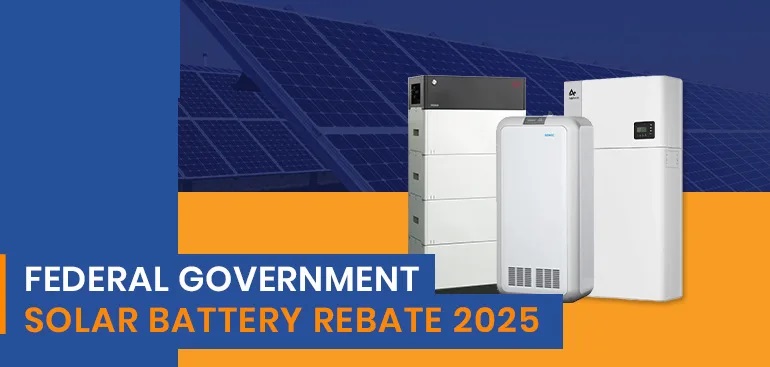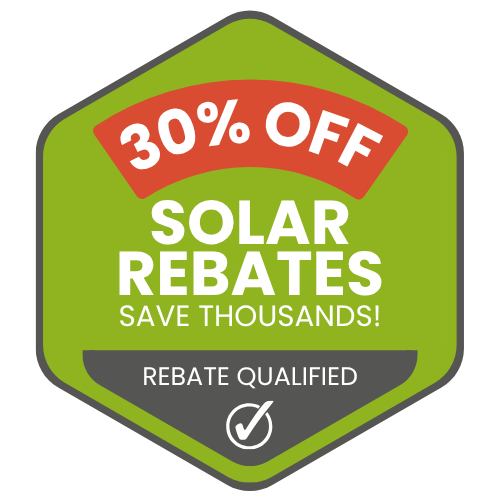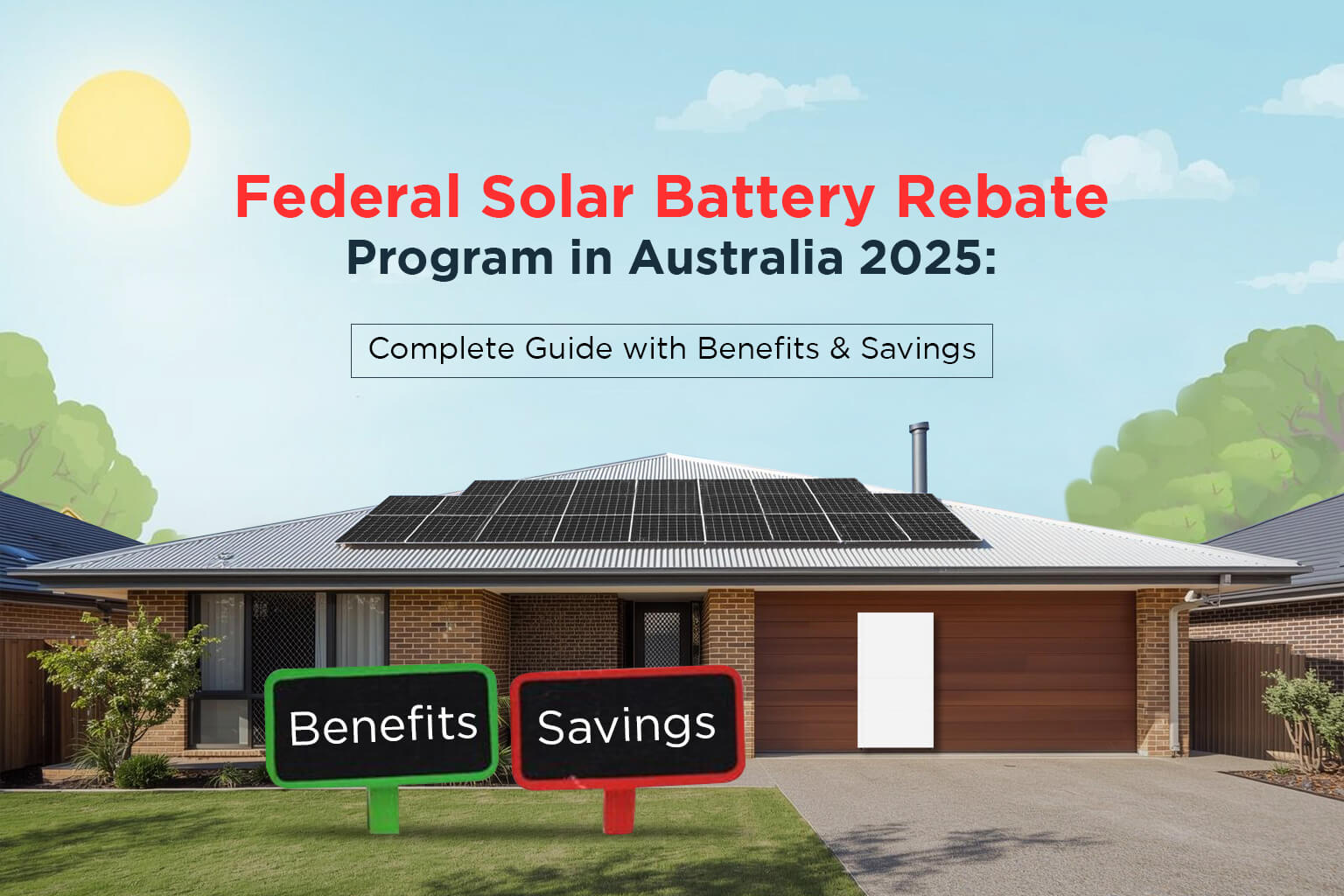Introduction: Why Solar Batteries Are Gaining Momentum in Australia?
Australia has been leading the way in solar energy for years. In fact, more than 3.5 million households now have rooftop solar, helping families cut down on electricity bills while relying less on fossil fuels.
But there’s still a catch: solar panels only work when the sun is shining. At night, most households are still dependent on grid electricity.
That’s where solar batteries come in. By storing the extra energy your panels produce during the day, a battery lets you use your own clean power after the sun goes down. This means more energy independence, better control over rising electricity costs, and even backup power during blackouts.
Recognising how important this shift is, the Australian Government is introducing the Federal Solar Battery Rebate in 2025. This rebate makes home batteries more affordable by reducing upfront costs, so more families can embrace the technology and enjoy long-term savings.
What Is the 2025 Federal Solar Battery Rebate in Australia?
The 2025 Federal Solar Battery Rebate is a key part of Australia’s push to speed up the shift to renewable energy. Its goal is simple: to make solar batteries more affordable for everyday households, so more families can store and use their own clean power.
From July 1, 2025, the government will launch the Cheaper Home Batteries Program, offering eligible households an upfront discount of around 30% off the cost of a home battery system.
What does that really mean for you? With today’s Small-scale Technology Certificate (STC) value sitting at about $36 (after admin costs), families can expect to save roughly $335 for every usable kilowatt-hour (kWh) of battery capacity installed. On a typical home battery, that can add up to thousands of dollars in savings.
The rebate won’t last forever, though. It will gradually reduce each year until the program finishes in 2030.
This initiative is powered by a $2.3 billion boost to the Small-scale Renewable Energy Scheme (SRES), the very same program that kick-started Australia’s rooftop solar boom. Now, it’s set to do the same for home batteries, helping more Australians cut bills, gain energy independence, and support a cleaner future.

Government’s Renewable Energy Goals
The rebate aligns with the government’s ambitious target of achieving 82% renewable energy by 2030. Encouraging widespread battery adoption ensures more efficient use of solar energy while reducing dependence on fossil-fuel-powered electricity grids.
Difference Between Solar Panel and Solar Battery Rebates
It’s important to distinguish between solar panel rebates and solar battery rebates:
- Solar Panel Rebate (Small-scale Renewable Energy Scheme – SRES): Provides certificates (STCs) to reduce the upfront cost of solar panel systems.
- Solar Battery Rebate: Specifically applies to energy storage solutions, reducing the cost of adding a battery to an existing or new solar system.
In 2025, these rebates can work together — first reducing the cost of your solar panels, then lowering the cost of your solar battery.
Key Takeaways of the Solar Battery Rebate Program
- Start Date: 1 July 2025
- Rebate Value: Up to 9.3 STCs per usable kWh (~$335 per kWh based on $36 STC price)
- Typical Savings: Around $4,000* on a standard 11.5–13.5 kWh battery
- Eligibility: Homeowners, small businesses, and community facilities
- Stackable: Yes, can be combined with eligible state rebates
- Means-Tested: No — available to all eligible property owners
- Installation: Must be certified (Certificate of Electrical Compliance) on or after 1 July 2025
- Battery Size: 5–100 kWh nominal capacity (rebate capped at first 50 kWh of usable capacity)
- Solar Requirement:
Must be paired with existing or new rooftop solar - Limit: One rebate per electricity meter; multiple properties with separate meters may qualify individually

Who Is Eligible for the Federal Solar Battery Rebate 2025?
Not every household automatically qualifies for the rebate. The government has set specific eligibility criteria to ensure support reaches the right families.
Income Thresholds and Household Criteria
- Households with an annual income below $180,000* are more likely to qualify.
- Priority is often given to low- and middle-income households to encourage equitable access.
- Owner-occupiers and landlords may be eligible, depending on state and territory rules.
Geographic Eligibility Across States and Territories
While the federal rebate applies nationwide, availability may differ depending on:
- State-level policies.
- Demand and funding allocations.
- Whether local energy providers are participating.
Types of Properties That Qualify
- Detached houses and townhouses.
- Some rental properties (with landlord approval).
- Small businesses may be eligible under separate schemes.
A few more tips for your reference :
The program requires battery systems to meet specific technical and installation standards:
- Nominal capacity between 5 and 100 kWh
- Rebate applies to up to 50 kWh of usable capacity
- Must be brand new (no second-hand or refurbished batteries)
- Installed on-grid or off-grid (off-grid must be 1 km+ from main grid or face high connection costs)
- On-grid systems must be Virtual Power Plant (VPP) capable
- Paired with new or existing rooftop solar
- Battery and inverter must be on the Clean Energy Council (CEC) approved product list
Households can also claim the rebate when adding extra batteries to an existing solar system, as long as the system hasn’t already received the rebate. To qualify, the new battery capacity needs to be at least 5 kWh, and the total system size must stay under 100 kWh.
How Much Can You Save with the Solar Battery Rebate?
The biggest question Australians are asking: How much money will this actually save me?
Average Battery Costs Before and After Rebate
- Typical solar battery costs in 2025 range between $8,000 – $15,000*, depending on capacity and brand.
- With the rebate, households can save up to $3,000 – $4,000* on upfront installation.
Real-Life Savings for Australian Households
- A family in Melbourne with a 10kWh battery may save around $1,200* annually on electricity bills.
- Households in Sydney with higher evening energy use could save even more.
- Over a 10-year lifespan, savings may exceed $10,000*, making the system highly cost-effective.
(Note* : Please confirm the price with your local vendor)
Essential Installer and Compliance Requirements You Should Consider :
- Installation by a Solar Accreditation Australia (SAA) accredited installer
- On-site supervision by the accredited installer
- Compliance with the Best Practice Guide: Battery Storage Equipment and all relevant state/territory electrical safety regulations
- Internet connectivity confirmation for VPP-capable systems (connection to VPP not mandatory)
- Certificate of Electrical Compliance (CoC) signed on or after 1 July 2025
Would You Like to Check the Estimate of Your Savings?
Want to know how much you could save through a cheaper solar battery rebate program?
Contact Solar Miner now at 1300285885 for a free, no-obligation quote and personalized rebate estimate.
How to Apply for the 2025 Solar Battery Rebate
Applying for the rebate is straightforward but requires careful attention to detail.
Step-by-Step Application Process
- Check Eligibility: Confirm income, property type, and state guidelines.
- Get Quotes: Request multiple quotes from Clean Energy Council (CEC)-accredited installers.
- Submit Application: Provide required documents online via the federal rebate portal.
- Approval & Installation: Once approved, schedule installation with your chosen provider.
- Claim Rebate: The rebate is usually applied upfront by the installer, reducing your invoice.
Required Documents and Verification
- Proof of income (tax return or payslip).
- Proof of property ownership (rates notice, mortgage statement).
- Solar system compliance certificate.
Common Mistakes to Avoid
- Applying before confirming installer accreditation.
- Submitting incomplete documents.
- Failing to apply within rebate deadlines.
Top Benefits of Installing a Solar Battery in 2025
Installing a solar battery is more than just about cost savings; it’s a lifestyle upgrade.
Lower Electricity Bills and Energy Independence
By storing solar power during the day and using it at night, you can cut your grid reliance by up to 70%.
Support for a Greener Future
Every household battery reduces reliance on coal-fired electricity, directly lowering carbon emissions.
Increased Property Value
Homes with solar + battery systems are increasingly attractive to buyers, boosting resale values.
Federal vs State Solar Battery Rebates
Beyond the federal rebate, states also offer their own programs.
Victoria’s Solar Homes Program
- Offers up to $4,174 off solar battery installations.
- Additional loans available for low-income households.
New South Wales Incentives
- Interest-free loans for solar battery systems.
- Pilot programs in select regions.
Comparison Table of Federal and State Rebates
| State | Federal Rebate | State Incentive | Potential Combined Savings |
| VIC | Up to $3,500* | Up to $4,174 | $7,500+* |
| NSW | Up to $3,500* | Interest-free loan | $3,500* + loan |
| QLD | Up to $3,500* | Regional pilot program | Varies |
| SA | Up to $3,500* | Virtual Power Plant (VPP) credits | Varies |
(Note* : Please confirm the price with your local vendor)
Best Solar Battery Brands Eligible for Rebate
Choosing the right battery is crucial for long-term performance. So we are showcasing some of the popular battery storage brands for your reference.
Common Rebate-Eligible Battery Brands in Australia
Based on Clean Energy Council approvals and rebate program criteria, here are some widely listed battery brands and models:
1. Tesla Powerwall 2 & Powerwall 3
- Strongly approved across federal rebate and state schemes like VIC, NSW, SA
- Features: ~13.5 kWh capacity, 10-year warranty, VPP compatibility
2. Sungrow (SBR & SBH Series)
- Modular capacities (approx 9.6–25.6 kWh), high efficiency, 10-year warranty, VPP-compatible.
3. Alpha ESS (Smile Series)
- Offers systems ranging 5–30 kWh, hybrid options, 10-year warranty, rebate-approved.
4. BYD Battery-Box (HVM / HVS)
- Scalable modular design (5.1–22.1 kWh), LiFePO₄ chemistry, included on CEC list, rebate-eligible.
5. Enphase IQ Battery (5P)
- AC-coupled, modular ~4.96 kWh units; approved for rebate, VPP-ready.
6. LG Chem RESU
- Compact lithium-ion batteries (6.5–13 kWh); when available, often listed for state rebates.
7. Sonnen Batterie
- Modular, smart energy systems—often listed for rebate eligibility.
8. 1KOMMA5° (Models 1K5-BAT-4660-L2 to L9)
- Scalable 8.4–37.7 kWh; VPP-ready and approved until 2028.
9. Sigenergy (SigenStor Series)
- All-in-one energy management systems, modular up to large sizes; increasingly popular; rebate-eligible.
10. Pylontech (Force-L2 Series, US2000, US3000)
- Modular LiFePO₄ batteries; accepted if paired with VPP-compatible inverters.
11. Other Brands Mentioned
- Growatt, Jinko (SunTank), LAVO (hydrogen-based), PowerPlus, RedEarth, SolaX, SAJ, some models may qualify if they meet requirements and are paired with approved systems.
Quick Reference Table
| Brand / Model | Capacity Range | VPP-Ready | Common Rebate Eligibility |
| Tesla Powerwall 2 & 3 | ~13.5 kWh | Yes | Federal & multiple state rebates |
| Sungrow (SBR & SBH) | ~9.6–25.6 kWh | Yes | Federal & state rebates |
| Alpha ESS (Smile Series) | ~5–30 kWh | Yes | Federal & state rebates |
| BYD Battery-Box (HVM/HVS) | ~5.1–22.1 kWh | Yes | Federal & state rebates |
| Enphase IQ Battery 5P | ~4.96 kWh modules | Yes | Federal (size ≥5 kWh) & state rebates |
| LG Chem RESU | ~6.5–13 kWh | Yes | State rebates (availability varies) |
| Sonnen Batterie | Modular systems | Yes | Federal & state rebates |
| 1KOMMA5° models | ~8.4–37.7 kWh | Yes | Federal rebates (CEC approved) |
| Sigenergy SigenStor | Modular (5–30kWh+) | Yes | Federal & state rebates |
| Pylontech Force-L2 / US Series | Modular LiFePO₄ | Yes | Federal & some state rebate eligibility |
Next Steps
- Check availability — Some models like LG RESU may have supply fluctuations.
- Confirm your system meets criteria— VPP-ready, CEC-listed, 5–50 kWh capacity, commissioned post-July 1, 2025.
- Stack rebates — Combine federal rebates with state programs like those in NSW, NT, Victoria, etc.
- Consult your installer — They can verify eligible models, handle accreditation, and manage applications.
In summary, Popular and rebate-eligible battery brands in Australia as of mid-2025 include Tesla (Powerwall 2 & 3), Sungrow, Alpha ESS, BYD Battery-Box, Enphase IQ Battery, LG Chem RESU, Sonnen, 1KOMMA5°, Sigenergy, and Pylontech. Confirm your chosen model’s eligibility with an accredited installer to make the most of both federal and state incentives.
How Long Will the 2025 Federal Solar Battery Rebate Last?
Funding Limits and Deadlines
The rebate operates under a limited funding model. Once allocations are exhausted, households must wait for future rounds.
Why Apply Early Matters
- Early applicants secure the highest rebate value.
- Delays may reduce savings as funding phases out.
Final Thoughts: Is the Solar Battery Rebate a Game-Changer?
The new solar battery rebate has the potential to be a real game-changer for Australian households. With a 30% upfront discount, rising power bills, lower feed-in tariffs, and steadily falling battery prices, the rebate is expected to spark a big shift in the home energy market.
That said, early demand could be so strong that supply and installation times may face short-term delays. If you’re keen to take advantage, it’s smart to lock in your battery now and arrange for it to be activated once the program officially kicks off on 1 July 2025. Many modern batteries even allow remote activation, making the process smoother and more convenient.
Frequently Asked Questions (FAQs)
1. Can I get both solar panel and battery rebates in 2025?
Yes. The solar panel rebate (STCs) and solar battery rebate can be combined, significantly reducing upfront costs.
2. Do I need solar panels to qualify for a battery rebate?
Generally yes, but some programs allow standalone batteries if they connect to renewable energy systems.
Q3: How much can I actually save with the rebate?
You’ll save about $335 for every usable kilowatt-hour (kWh) of battery storage. For most households, this means:
- A 10 kWh battery = around $3,350 saved
- A 12 kWh battery = around $4,020 saved
- A 13.5 kWh battery = up to $4,500 saved
So, on an average-sized system (11.5–13.5 kWh), you’re typically looking at savings of about $4,000 upfront.
Q4: Who can apply for the rebate?
The rebate is open to homeowners, small businesses, and community organisations that have eligible properties and install a battery system paired with rooftop solar.
Q5: Can I use this rebate together with state incentives?
Yes, in some states you can. For example, households in Western Australia and New South Wales may be able to stack the federal rebate with local support programs. Just keep in mind that rules vary by state.
Q6: Are second-hand or refurbished batteries covered?
No. Only brand-new battery systems qualify for the rebate.
Q7: Can I get my battery installed before July 1 and still claim the rebate?
Yes. You can arrange installation before July 1, 2025, but the system must stay switched off until the rebate officially begins. Many modern batteries even allow remote activation, making this process much smoother.
Q8: What battery size qualifies for the rebate?
To be eligible, batteries need to be at least 5 kWh in size but no more than 100 kWh. The rebate itself will only apply to the first 50 kWh of usable capacity.
Q9. Is there a rebate for renters?
Some state-level programs allow landlords to install batteries in rental properties, but tenants must usually gain landlord approval.
Q10. How long does approval take?
Typically 2–4 weeks, depending on application volumes and document accuracy.
Q11. Are there rebates for small businesses?
Yes. While primarily targeted at households, some rebates and grants are available for small business operators.
Q12. Where can I find more information?
Visit the Clean Energy Regulator website for official updates.
Conclusion: Why 2025 Is the Best Year to Invest in Solar Batteries
The 2025 Federal Solar Battery Rebate in Australia is a golden opportunity for households to cut energy bills, boost energy independence, and support Australia’s clean energy transition. With combined federal and state rebates, upfront costs are lower than ever, making solar batteries accessible for more Australians.
If you’ve been considering solar storage, now is the time to act. Rebates are limited, and the earlier you apply, the more you stand to save. Whether it’s reducing your electricity bills, increasing property value, or contributing to a greener planet, the benefits of solar batteries in 2025 are simply too good for a future-proof solution.





